2014 Volume 54 Issue 2 Pages 254-258
2014 Volume 54 Issue 2 Pages 254-258
This article describes application of computational simulation for manufacturing of castings using investment casting technique. A mathematical model was created describing the process of melted metal pouring into the ceramic shell with its further solidification. Using this model the process of manufacturing single-crystal patterns from heat-resistant nickel superalloy was simulated. The obtained computational model was verified by the temperature measuring of the real-life production experiment. Using mathematical simulation the speed of the patterns moving out was optimized to increase temperature gradient on the casting.
One of the techniques used for manufacturing high-quality machines components is investment casting which allows in one operation to manufacture complex geometry castings (including thin-walls blades) for expensive heat-resistant alloys which are not very machinable.1) But due to the production process complexity and large number of factors influencing on the resulted product quality solidification should be checked especially strictly. Mathematical simulation of processes associated with components manufacture by investment castings allows to reduce costs because gating system design and temperature-time parameters of the technological process are exercised in mathematical model virtual space instead of real-life expensive casts. Low cost and short time of computational experiment execution as well as large volume and visualization of the obtained information about the technological process progress and quality of the future casting make computational simulation an important research tool.2)
This topic is novelty and scantily investigated. Earlier, this problem was considered in.3) This work studies the process of manufacturing single-crystal patterns from heat-resistant nickel alloys. A mathematical model is built which describes this process. The model is verified by comparing the data obtained by computational experiment with temperature measuring results. Mathematical model application is examined in terms of optimizing the speed of the casting moving out of shells preheating furnace.
Let us study the process of manufacturing single-crystal patterns from heat-resistant nickel alloys. The partners are casted in a special-purpose machine of direct solidification. Solidification is proceeding simultaneously in two shells obtained by investment casting and poured with ceramics as per Shaw technique.4) Each shell consists of three patterns.
Before the pouring the melted material the shells are heated in a furnace during 4200 seconds up to process-oriented temperature. Then the melted nickel alloy is poured in. From the moment of pouring up to shells moving out the patterns are conditioned within ten minutes. Inside the machine during the whole process the temperature is maintained at the level higher than the alloy liquidus point. Solidification and single-crystal structure perfection are defined by the speed of shells moving out of the heating module. Now we will describe the mathematical process. Figure 1 shows the circuit of the casting manufacturing including the ceramic shell, Shaw ceramics and the region of the casting formation.
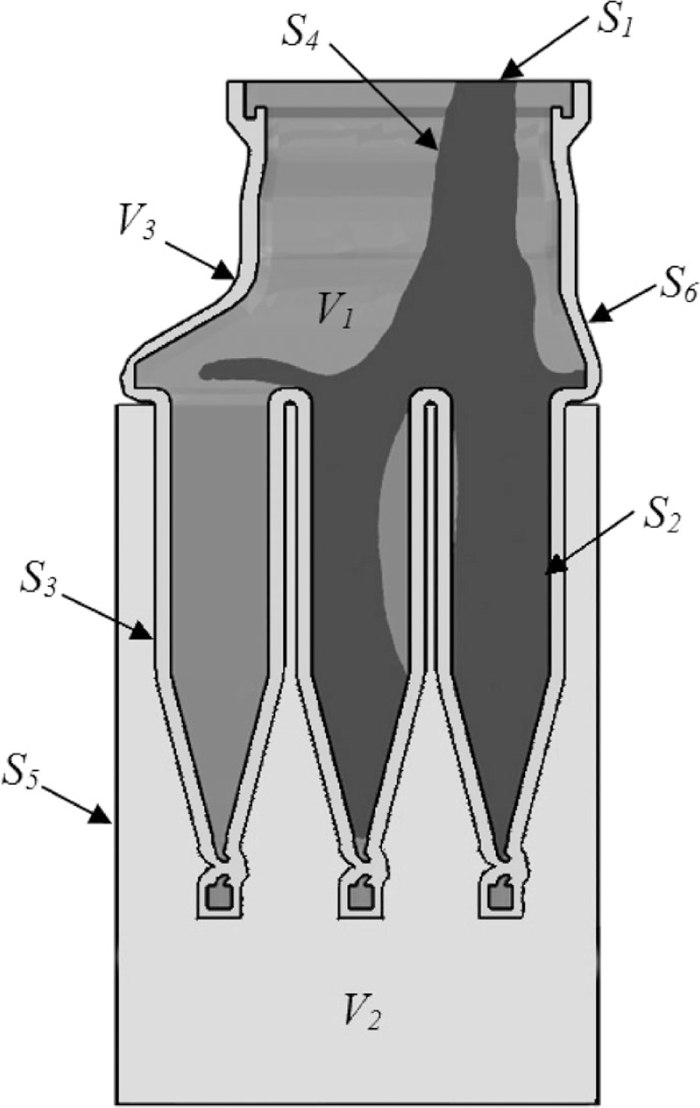
Scheme of castings manufacturing process, where V1 – area of casting body, V2 – Shaw ceramics, VS3 – shell, S1 – boundary for metal pouring, S2 – boundary of metal and shell interference, S3 – boundary of Shaw ceramics and shell interference, S4 – metal free surface, S5 – Shaw ceramics free surface, S6 –shell free surface.
Non-stationary thermal profiles in computational area while pouring metal and solidification is studied using differential equation of heat conductivity.
Heat conductivity equation additionally is completed with boundary conditions on the surface of the shell-casting contact:
On the boundaries of heat conductivity with environment the conditions are as follows:
Heat transfer conditions between the Shaw ceramics and the shell are considered to be ideal. T2 = T3
Initial conditions are transferred to the pored metal temperature and the shell with Shaw ceramics
To model the process of melted metal pouring into the ceramic shell and to calculate heat and mass transfer the motion differential equation is applied. In computational area we consider non-isothermal laminar flow of non-compressed Newtonian viscous liquid. Phase interface is not clearly distinguished.
The motion equation is additionally completed with the evolutionary equation of compressible medium continuity in liquid phase area to meet the mass conservation law:
The motion equation is additionally completed with the following boundary conditions:
Free surface geometry S4 is defined as related to time through relationship of simple stress and metal surface tension
At the boundary S2 for the solidified metal the speed
It is assumed that at initial point at surface
Considering the abovementioned mathematical relations the finite-element model of single-crystal patterns manufacture was built. Solution area included casting body, shell and Shaw ceramics.4) Cooling conditions were specified using special boundary conditions (Fig. 2).
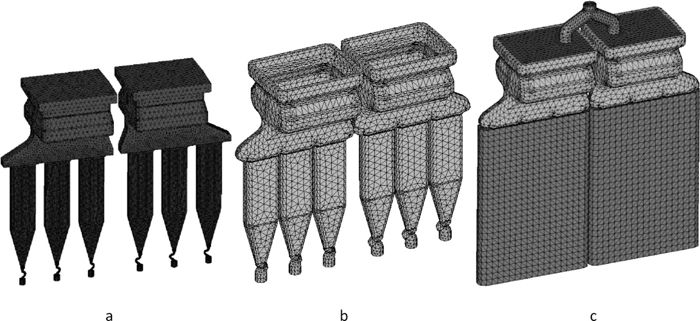
Finite-element model of (a) casting, (b) shell, (c) the whole computational area.
To simulate the process of pouring and solidification of the air cleaner case we used the multi-purpose software solution and in particular ProCAST system of casting process computer simulation (Fig. 3).
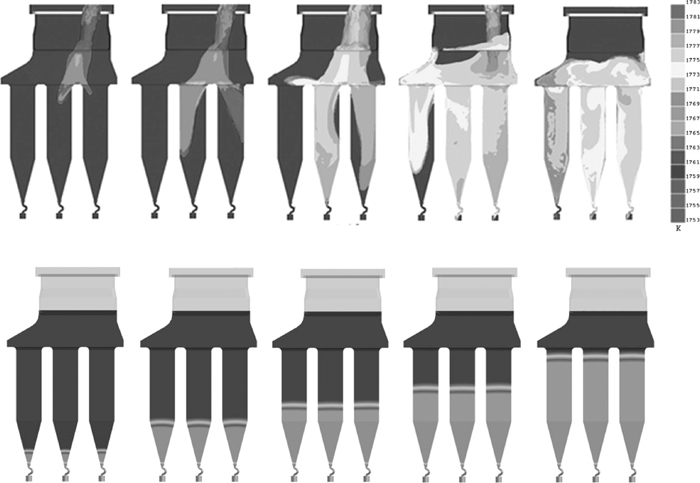
Results of computational simulation of pouring heat-resistant nickel super-alloy and its further solidification.
To verify the proposed mathematical model an experiment was conducted at Aviadvigatel’s development plant for manufacturing single-crystal patterns from nickel superalloy. During the work a special-purpose vacuum furnace was used for the preheating of the shells. Two modules were poured in the preliminary heated shells. After certain time the patterns were slowly moved out of the furnace to achieve flat thermal gradient opposite to crystals growth direction.
At carrying out full-scale experiment the ceramic shell and the casting cavity were fitted with special-purpose thermal sensors with numbers 7…12 (thermocouples arrangement is given in Fig. 4). Thermocouples with odd numbers showed the temperature in the ceramic shell and the thermocouples with even numbers – in the casting.
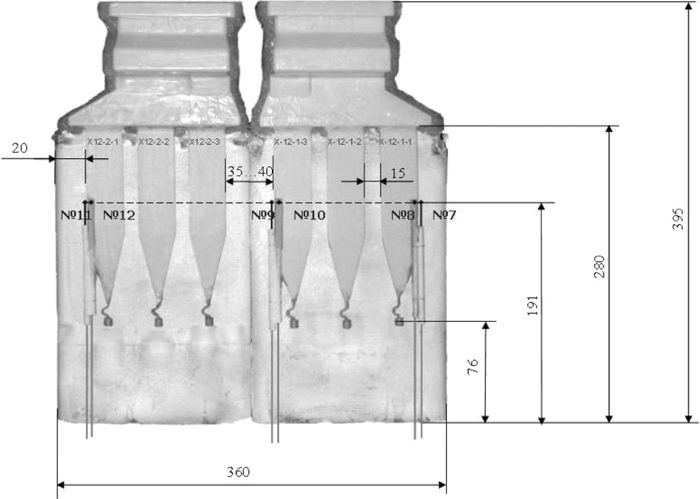
Thermocouples arrangement in the ceramic shell (geometrical sizes are given in ×10–3 m).
The obtained thermocouples readings were interpolated into the temperature-time relationship curves. These curves were compared with computational calculation results in points corresponding to sensors arrangement. Figure 5 show comparison of computational calculations with the thermocouples data in the shell and in the casting correspondingly.

Comparison of the thermocouples data with the temperature evolution in the relative component using computational simulation. Calculation results are shown in grey and the thermocouple data – in black. The Figure left side refers to the shells and the right side – to the castings.
Absolute accuracy for mathematical model didn’t exceed 10°С that is less than 1% in solidification temperature intervals. Therefore correspondence between numerical simulation results and experimental data was proved. It confirms the possibility of numerical models wide application in production process.
Having proved that numerical model truly reflects thermal processes in a casting assembly let us modify the production process to improve the patterns structure.
One of the quality parameters is the thermal gradient width which is influence by the shell moving out speed. Therefore we will optimize the speed of the shell moving out of the furnace to achieve maximum temperature gradient. As an optimized function let us chose the width of solidification front-line and let it tend to a minimum. For optimization we use gradient descend method with a constant step.
Where λ = 0.5 – the selected step for the gradient descend method.
Criteria for breaking the process of minimum definition:
As a result for speed a temporary relationship was obtained (Fig. 4). For convenient application of the optimized speed function in the production process it was approximated by the straight line (Fig. 6).
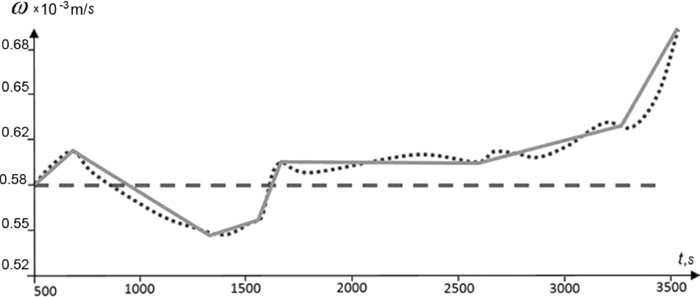
The patterns moving out speed (the light dashed line shows the speed before optimization, the dark dotted line shows the speed mode calculated using the optimization, the solid line shows the piecewise linear approximation of the optimized speed mode).
It can be emphasized that on pattern castings the solid-liquid area width reduced sufficiently after optimization. Therefore the change of the patterns moving out speed led to the gradient increase in the castings.
Table 1 specifies thermal gradient along the casting length before and after optimization of the moving out speed.
| Casting part | At the beginning of the starting cone | At the end of the starting cone | At the beginning of the casting body | In the middle of the casting body | At the end of the casting body |
|---|---|---|---|---|---|
| Before optimization | 3.4 × 10–3 K/m | 2.3 × 10–3 K/m | 1.5 × 10–3 K/m | 1.3 × 10–3 K/m | 1.4 × 10–3 K/m |
| After optimization | 5.0 × 10–3 K/m | 4.2 × 10–3 K/m | 3.7 × 10–3 K/m | 3.4 × 10–3 K/m | 4.7 × 10–3 K/m |
Hence computational analysis application allows not only to study single-crystal structure formation from inside but also provides a possibility of carrying out numerical experiments for investigating process and design parameters influence on manufacturing single-crystal castings of gas turbine engine parts which is problematic and unreasonably expensive if it is done at real-life patterns. It allows to increase the quality of manufactured castings sufficiently and to minimize the risk of possible defects occurrence.